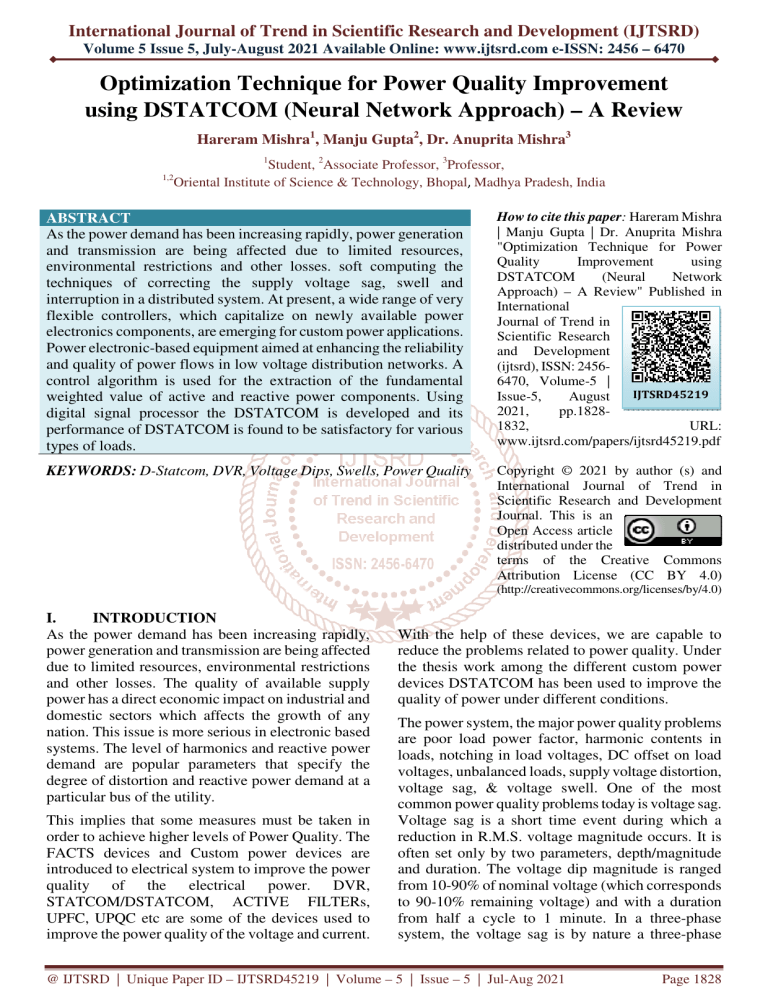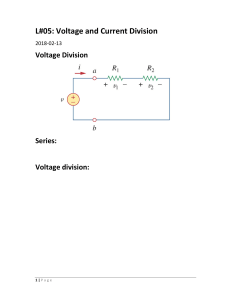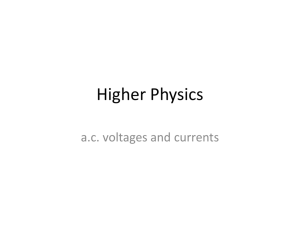
International Journal of Trend in Scientific Research and Development (IJTSRD)
Volume 5 Issue 5, July-August 2021 Available Online: www.ijtsrd.com e-ISSN: 2456 – 6470
Optimization Technique for Power Quality Improvement
using DSTATCOM (Neural Network Approach) – A Review
Hareram Mishra1, Manju Gupta2, Dr. Anuprita Mishra3
1
Student, 2Associate Professor, 3Professor,
1,2
Oriental Institute of Science & Technology, Bhopal, Madhya Pradesh, India
ABSTRACT
As the power demand has been increasing rapidly, power generation
and transmission are being affected due to limited resources,
environmental restrictions and other losses. soft computing the
techniques of correcting the supply voltage sag, swell and
interruption in a distributed system. At present, a wide range of very
flexible controllers, which capitalize on newly available power
electronics components, are emerging for custom power applications.
Power electronic-based equipment aimed at enhancing the reliability
and quality of power flows in low voltage distribution networks. A
control algorithm is used for the extraction of the fundamental
weighted value of active and reactive power components. Using
digital signal processor the DSTATCOM is developed and its
performance of DSTATCOM is found to be satisfactory for various
types of loads.
How to cite this paper: Hareram Mishra
| Manju Gupta | Dr. Anuprita Mishra
"Optimization Technique for Power
Quality
Improvement
using
DSTATCOM
(Neural
Network
Approach) – A Review" Published in
International
Journal of Trend in
Scientific Research
and Development
(ijtsrd), ISSN: 24566470, Volume-5 |
IJTSRD45219
Issue-5,
August
2021,
pp.18281832,
URL:
www.ijtsrd.com/papers/ijtsrd45219.pdf
KEYWORDS: D-Statcom, DVR, Voltage Dips, Swells, Power Quality
Copyright © 2021 by author (s) and
International Journal of Trend in
Scientific Research and Development
Journal. This is an
Open Access article
distributed under the
terms of the Creative Commons
Attribution License (CC BY 4.0)
(http://creativecommons.org/licenses/by/4.0)
I.
INTRODUCTION
As the power demand has been increasing rapidly,
power generation and transmission are being affected
due to limited resources, environmental restrictions
and other losses. The quality of available supply
power has a direct economic impact on industrial and
domestic sectors which affects the growth of any
nation. This issue is more serious in electronic based
systems. The level of harmonics and reactive power
demand are popular parameters that specify the
degree of distortion and reactive power demand at a
particular bus of the utility.
This implies that some measures must be taken in
order to achieve higher levels of Power Quality. The
FACTS devices and Custom power devices are
introduced to electrical system to improve the power
quality of the electrical power. DVR,
STATCOM/DSTATCOM, ACTIVE FILTERs,
UPFC, UPQC etc are some of the devices used to
improve the power quality of the voltage and current.
With the help of these devices, we are capable to
reduce the problems related to power quality. Under
the thesis work among the different custom power
devices DSTATCOM has been used to improve the
quality of power under different conditions.
The power system, the major power quality problems
are poor load power factor, harmonic contents in
loads, notching in load voltages, DC offset on load
voltages, unbalanced loads, supply voltage distortion,
voltage sag, & voltage swell. One of the most
common power quality problems today is voltage sag.
Voltage sag is a short time event during which a
reduction in R.M.S. voltage magnitude occurs. It is
often set only by two parameters, depth/magnitude
and duration. The voltage dip magnitude is ranged
from 10-90% of nominal voltage (which corresponds
to 90-10% remaining voltage) and with a duration
from half a cycle to 1 minute. In a three-phase
system, the voltage sag is by nature a three-phase
@ IJTSRD | Unique Paper ID – IJTSRD45219 | Volume – 5 | Issue – 5 | Jul-Aug 2021
Page 1828
International Journal of Trend in Scientific Research and Development @ www.ijtsrd.com eISSN: 2456-6470
phenomenon which affects both the phase-to-ground
and phase-to-phase voltages. The faults are singlephase or multiple-phase short-circuit, which leads to
high currents[1].
The introduction of FACTS has given the new
direction to the power system to solve the power
quality problems. At present, a wide range of very
flexible controllers are emerging for custom power
applications. The FACTS controllers like SVC,
TCSC, TCPST, STATCOM, SSSC, UPFC, etc. are
mainly used controllers. Among these, the
STATCOM is the most effective device. The
STATCOM is a shunt device & based on VSC
principle. The inverter circuit along with interface
transformers/inductors is called a STATCOM.
II.
VOLTAGE SOURCE CONVERTER
(VSC) and CUSTOM POWER DEVICES
A voltage-source converter is a power electronic
device, which can generate a sinusoidal voltage with
any required magnitude, frequency and phase angle.
The VSC is used to either completely replace the
voltage or to inject the ‘Dip voltage’. The ‘Dip
voltage’ is the difference between the nominal
voltage and the actual. The converter is normally
based on some kind of energy storage i.e. capacitor,
which will supply the converter with a DC voltage.
The solid-state electronics in the converter is then
switched to get the desired output voltage. Normally
the VSC is not only used for voltage dip mitigation,
but also for other power quality issues, e.g. flicker
and harmonics.
A. Shunt voltage controller [Distribution Static
Compensator (DSTATCOM)]
The D-STATCOM (Distribution Static Compensator)
configuration consists of a VSC, a DC energy storage
device; a coupling transformer connected in shunt
with the ac system, and associated control circuits.
Fig. 1,
Shows the basic configuration of D-STATCOM.
Here, such device is employed to provide continuous
voltage regulation using an indirectly controlled
converter. Suitable adjustment of the phase and
magnitude of the D-STATCOM output voltages
allows effective control of active and reactive power
exchanges between the D-STATCOM and the AC
system.
The VSC connected in shunt with the AC system
provides a multifunctional topology which can be
used for up to three quite distinct purposes:
A. Voltage regulation and compensation of reactive
power
B. Correction of power factor
C. Elimination of current harmonics.
Figure 1 shows the shunt injected current Ish corrects
the voltage sag by adjusting the voltage drop across
the system impedance Zth. The value of Ish can be
controlled by adjusting the output voltage of the
converter.
Ish = IL – Is
It is mentioned that the effectiveness of the
STATCOM in correcting voltage sag depends on the
value of Zth or fault level of the load bus. When the
shunt injected current Ish is kept in quadrature with VL
the desired voltage correction can be achieved
without injecting any active power into the system.
On the other hand, when the value of Ish is minimized,
the same voltage correction can be achieved with
minimum apparent power injection into the system.
B. Dynamic voltage restorer / regulator (DVR)
The Dynamic Voltage Restorer (DVR) is a series
connected device analogous to a SSSC. The main
function of a DVR is to eliminate or reduce voltage
sags seen by sensitive loads such as semiconductor
manufacturing plant or IT industry.. They have been
designed to compensate three phase voltage sags up
to 35% for duration of time less than half a second
(depending on the requirement). If the voltage sag
occurs only in one phase (caused by SLG faults) then
the DVR may be designed to provide compensation
for sags exceeding 50%. A DVR is connected in
series with the feeder using a transformer. The low
voltage winding is connected to the converter. A
DVR with IGBT/IGCT devices can be controlled to
act as a series active filter to isolate the load from
voltage harmonics on the source side. It is also
possible to balance the voltage on the load side by
injecting negative and/or zero sequence voltages in
addition to harmonic voltages.
Figure 1 Schemetic Dig of D-STATCOM
@ IJTSRD | Unique Paper ID – IJTSRD45219 | Volume – 5 | Issue – 5 | Jul-Aug 2021
Page 1829
International Journal of Trend in Scientific Research and Development @ www.ijtsrd.com eISSN: 2456-6470
and currents. A neural network with memory is used
to identify the nonlinear load admittance. Once
training is achieved, the neural network predicts the
true harmonic current of the load when supplied with
a clean sine wave. Feed forward back propagation
(BP) artificial neural network (ANN) consists of
various layers such as the input layer, hidden layer,
and output layer. It is based on feed forward BP with
a high ability to deal with complex nonlinear
problems.
Figure 3: Basic configuration of DVR
C. UNIFIED
POWER
QUALITY
CONDITIONER (UPQC)
Unified power quality conditioners are viable
compensation devices that are used to ensure that
delivered power meets all required standards and
specifications at the point of installation.
Figure 4: Basic Configuration of UPQC
The ideal UPQC can be represented as the
combination of a voltage source converter (injecting
shunt current) and a common DC link (connected to a
DC capacitor).
UPQC consist of combined series active power filter
that compensates voltage harmonics of the power
supply, and shunt active power filter that compensates
harmonic currents of a non-linear load. This dual
functionality makes the UPQC as one of the most
suitable devices that could solve the problems of both
consumers as well as of utility. UPQC, thus can help
to improve voltage profile and hence the overall
health of power distribution system
SYSTEM CONFIGURATION AND
CONTROL
ALGORITHM
AND
PROPOSE WORK
The performance of any custom power device
depends very much upon the control algorithm used
for the reference current estimation and gating pulse
generation scheme. An implementation of a three
phase distribution static compensator (DSTATCOM)
using a control algorithm for its functions under
nonlinear loads such as load balancing and reactive
power compensation for power factor, and zero
voltage regulation. The main advantage of this
method is that it requires only waveforms of voltages
The BP control algorithm is also used to design the
pattern classification model based on decision support
system. The standard BP model has been used with
the full connection of each node in the layers from
input to the output layers. Some applications of this
algorithm are as to the identification of user faces,
industrial processes, data analysis, mapping data,
control of power quality improvement devices, etc.
The control of power quality devices by neural
network is a latest research area in the field of power
engineering. The extraction of harmonic components
decides the performance of compensating devices.
The BP algorithm which trained the sample can detect
the signal of the power quality problem in real time.
Its simulation study for harmonic detection is
presented. The proposed control algorithm is used for
harmonic suppression and load balancing in PFC and
zero voltage regulation (ZVR) modes with dc voltage
regulation of DSTATCOM. In this work, the
proposed control algorithm on a DSTATCOM is
implemented for the compensation of nonlinear loads.
A
voltage
source
converter(VSC)-based
DSTATCOM is connected to a three phase ac mains
feeding three phase linear/nonlinear loads with
internal grid impedance which is shown in Fig. 4
III.
Figure 4 Schematic diagram of VSC-based
DSTATCOM
@ IJTSRD | Unique Paper ID – IJTSRD45219 | Volume – 5 | Issue – 5 | Jul-Aug 2021
Page 1830
International Journal of Trend in Scientific Research and Development @ www.ijtsrd.com eISSN: 2456-6470
The performance of DSTATCOM depends upon the
accuracy of harmonic current detection. For reducing
ripple in compensating currents, the tuned values of
interfacing inductors (Lf) are connected at the ac
output of the VSC. A three phase series combination
of capacitor (Cf) and a resistor (Rf) represents the
shunt passive ripple filter which is connected at a
point of common coupling (PCC) for reducing the
high frequency switching noise of the VSC. The
DSTATCOM currents (icabc) are injected as required
compensating currents to cancel the reactive power
components and harmonics of the load currents so
that
loading
due
to
reactive
power
component/harmonics is reduced on the distribution
system. In this algorithm, the phase PCC voltages,
source current (isa,,isb, isc) and (iLa,,iLb, iLc) and dc bus
voltage (Vdc) are required for the extraction of
reference source currents. There are two primary
modes for the operation of this algorithm: The first
one is a feed forward, and the second is the BP of
error or supervised learning.
A BP training algorithm is used to estimate the three
phase weighted value of load active power current
components (Wap,Wbp,Wcp) and reactive power
current components (Waq,Wbq,Wcq) from polluted
load currents using the feed forward and supervised
principle. In this estimation, the input layer for three
phases (a, b, and c) is expressed as
The detail application of this algorithm for the
estimation of various control parameters is given as
follows.
Ilap=WO+iLauap+iLbubp++iLcucp
(1)
Ilbp=WO+iLauap+iLbubp++iLcucp
(2)
Ilcp=WO+iLauap+iLbubp++iLcucp
(3)
Where Wo is the selected value of the initial weight
and (uap,ubp,ucp) are the in-phase unit templates. Inphase unit templates are estimated using sensed PCC
phase voltages (Vsa,Vsb,Vsc) It is the relation of the
phase voltage and the amplitude of the PCC voltage
(Vt). The amplitude of sensed PCC voltages is
estimated as
and the output signals Zap,Zbp,Zcp of the feedforward
section are expressed as
(6)
(7)
(8)
The estimated values of Zap,Zbp,Zcp are fed to a
hidden layer as input signals. The three phase outputs
of this layer ILap1, ILbp1, ILcp1 before the activation
function are expressed as
Ilap1 = wO1+wapzap+wbpwbp++wcpucp
(9)
Ilap1 = wO1+wapzap+wbpwbp++wcpucp
(10)
Ilap1 = wO1+wapzap+wbpwbp++wcpucp
(11)
Where ( W01, Wap,Wbp,Wcp) are the selected value of
the initial weight in the hidden layer and the updated
values of three phase weights using the average
weighted value (Wp) of the active power current
component as a feedback signal, respectively. The
updated weight of phase “a” active power current
components of load current “Wap” at the nth sampling
instant is expressed as
where (n) and (n) are `the average weighted value of
the active power component of load currents and the
updated weighted value of phase “a” at the nth
sampling instant, respectively and wap1(n) and Zap(n)
are the phase “a” fundamental weighted amplitude of
the active power component of the load current and
the output of the feed forward section of the
algorithm at the nth instant, respectively. f(Iap1) and µ
are represented as the derivative of Iap1 components
and the learning rate. Similarly, for phase “b” and
phase “c,” the updated weighted values of the active
power current components of the load current are also
expressed as same. The extracted values of Iap1, Ibp1,
and Icp1 are passed through a sigmoid function as an
activation function to the estimation of the
fundamental active components in terms of three
phase weights wap1, wbp1, and wcp1 as
(4)
(13)
The in-phase unit templates of PCC voltages
(uap,ubp,ucp) are estimated as
(14)
(5)
The extracted values of ILap, ILbp, ILcp are passed
through a sigmoid function as an activation function,
(15)
IV.
CONCLUSION
Using this work, the investigation on the role of
DSTATCOM is carried out to improve the power
@ IJTSRD | Unique Paper ID – IJTSRD45219 | Volume – 5 | Issue – 5 | Jul-Aug 2021
Page 1831
International Journal of Trend in Scientific Research and Development @ www.ijtsrd.com eISSN: 2456-6470
quality in distribution networks with static linear and
non-linear loads. PI controller is used with the device
to enhance its performance. Test system is analyzed
and results are presented in the previous chapter.
DSTATCOM in the distribution networks under
different fault conditions and it can be concluded that
DSTATCOM effectively improves the power quality
in distribution networks with static linear. A VSCbased DSTATCOM has been accepted as the most
preferred solution for power quality improvement as
PFC and to maintain rated PCC voltage. A three
phase DSTATCOM has been implemented for the
compensation of nonlinear loads us a BPT control
algorithm to verify its effectiveness. The proposed
BPT control algorithm has been used for the
extraction of reference source currents to generate the
switching pulses for IGBTs of the VSC of
DSTATCOM.
V.
[1]
REFERENCES
International Journal of Scientific and Research
Publications, Volume 4, Issue 4, April 2014
ISSN 2250-3153.
[2]
Roger C. Dugan, Mark F. McGranaghan and H.
Wayne Beaty, Electrical Power, Systems
Quality, Tata Mc Graw- Hill. Pages 1-8 and 3980.
[3]
Bhim Singh, Alka Adya, A.P. Mittal, J.R.P
Gupta, “Power Quality Enhancement with
DSTATCOM for Small Isolated Alternator
feeding Distribution System”, conference on
Power Electronics and Drive Systems, vol.1,
pp. 274-279, 2005.
[4]
[5]
Alexander Kusko, Sc.D., P.E., Marc
T.Thompson, Ph.D., Power Quality in
Electrical Systems, Tata Mc Graw-Hill
publications, 2007.
H. Nasiraghdam and A. Jalilian, “Balanced and
Unbalanced Voltage Sag Mitigation Using
DSTATCOM with Linear and Nonlinear
Loads”, Conference on World Academy of
Science, Engineering and Technology, pp. 20–
25, 2007.
[6]
J. Sun, D. Czarkowski and Z. Zabar, “Voltage
Flicker Mitigation Using PWM-Based
Distribution STATCOM”, Conference on
Power Engineering Society Summer Meeting,
Publication, vol.1 ,pp. 616 – 621,2002.
[7]
Sung-Min, Woo Dae-Wook Kang, Woo-Chol
Lee and Dong-Seok Hyun, “The Distribution
STATCOM for Reducing the Effect of Voltage
Sag and Swell”, Conference on IECON’O1:
The 27th Annual Conference of the IEEE
Industrial Electronics Society Publication,
vol.2, pp.1132 - 1137,2001.
[8]
M. G. Molina, P. E. Mercado, “Control Design
and Simulation of DSTATCOM with Energy
Storage for Power Quality Improvements”,
Conference on IEEE PES Transmission and
Distribution Conference and Exposition Latin
America, Venezuela, pp.1 - 7, 2006.
[9]
Pierre Giroux, Gilbert Sybille Hoang Le-Huy,
“Modeling and Simulation of a Distribution
STATCOM using Sirnulink’s Power System
Blockset”, Conference on IECON 0l: The 27th
Annual Conference of the IEEE Industrial
Electronics Society, vol. 2, pp. 990 – 99, 2001.
[10]
Afshin Lashkar Ara and Seyed Ali Nabavi
Niaki, “Comparison of The Facts Equipment
Operation in Transmission and Distribution
Systems” Conference on 17th Internationaln
Conference on Electricity Distribution
Barcelona, vol.2, pp.44,2003.
[11]
Ben-Sheng Chen and Yuan-Yih Hsu, “An
Analytical Approach to Harmonic Analysis and
Controller Design of STATCOM”, Conference
on IEEE Transactions on Power Delivery,
vol.22, 2007
@ IJTSRD | Unique Paper ID – IJTSRD45219 | Volume – 5 | Issue – 5 | Jul-Aug 2021
Page 1832




